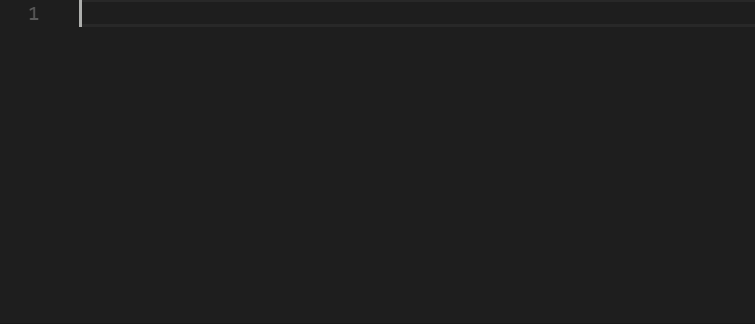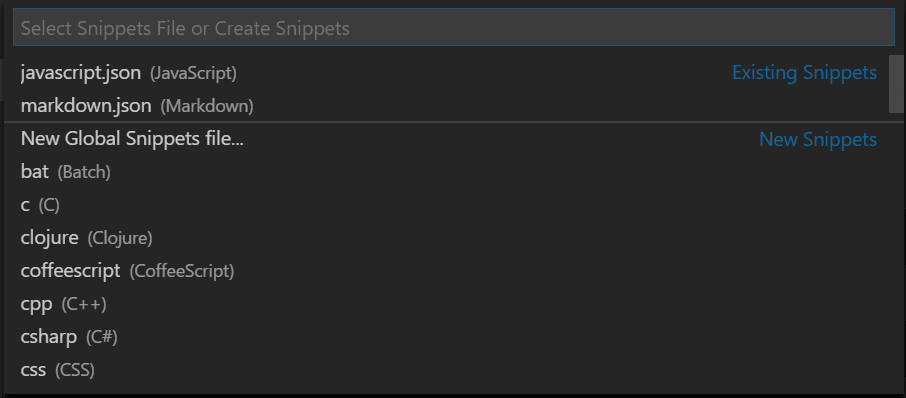
Code snippets are templates that make it easier to enter repeating code patterns, such as loops or conditional-statements.
In Visual Studio Code, snippets show in IntelliSense (⌃Space (Windows, Linux Ctrl+Space)) mixed with other suggestions as well as in a dedicated snippet picker (Insert Snippet in the Command Palette). There is also support for tab-completion: Enable it with "editor.tabCompletion": "on", type a snippet prefix, and press Tab to insert a snippet.
The snippet syntax follows the TextMate snippet syntax with the exceptions of 'interpolated shell code' and the use of \u; both are not supported.

Many extensions on the VS Code Marketplace include snippets. If you find one you want to use, install it and restart VS Code and the new snippet will be available (see here for more instructions on installing an extension). Marketplace
You can define your own snippets, either global snippets or snippets for a specific language. To open up a snippet file for editing, select User Snippets under File > Preferences (Code > Preferences on macOS) and select the language (by language identifier) for which the snippets should appear or create a new global snippet (New Global Snippets file).

Snippets are defined in a JSON format. The example below is a For Loop snippet you would use for JavaScript:
{
"For_Loop": {
"prefix": "for",
"body": [
"for (const ${2:element} of ${1:array}) {",
"\t$0",
"}"
],
"description": "For Loop"
}
}
In the example above:
For Loop is the snippet name.prefix defines how this snippet is selected from IntelliSense and tab completion. In this case for.body is the content and either a single string or an array of strings of which each element will be inserted as separate line.description is the description used in the IntelliSense drop down.The example above has two placeholders, ${1:array} and ${2:element}. You can quickly traverse them in the order of their number. The string after the number and colon is used as an initial default.
The file type and name define if a snippet is global or specific to a language. Snippets stored in a JSON file that is named after a language identifier (<languageId>.json) are language specific. For example, JavaScript-only snippets go in a javascript.json file.
Global snippets that are applicable whenever you are editing and are stored in <name>.code-snippets files, for example MyGlobal.code-snippets. The JSON schema of global snippets allows you to define a scope property which can filter the languages (based on language identifier) for which a snippet is applicable.
The sample below is the For Loop again but this time it is scoped to JavaScript and TypeScript.
{
"For_Loop": {
"prefix": "for",
"scope": "javascript,typescript",
"body": [
"for (const ${2:element} of ${1:array}) {",
"\t$0",
"}"
],
"description": "For Loop"
}
}
Once you have added a new snippet, you can try it out right away, no restart needed.
The body of a snippet can use special constructs to control cursors and the text being inserted. The following are supported features and their syntaxes:
With tabstops, you can make the editor cursor move inside a snippet. Use $1, $2 to specify cursor locations. The number is the order in which tabstops will be visited, whereas $0 denotes the final cursor position. Multiple occurrences of the same tabstop are linked and updated in sync.
Placeholders are tabstops with values, like ${1:foo}. The placeholder text will be inserted and selected such that it can be easily changed. Placeholders can be nested, like ${1:another ${2:placeholder}}.
Placeholders can have choices as values. The syntax is a comma separated enumeration of values, enclosed with the pipe-character, for example ${1|one,two,three|}. When the snippet is inserted and the placeholder selected, choices will prompt the user to pick one of the values.
With $name or ${name:default} you can insert the value of a variable. When a variable isn’t set, its default or the empty string is inserted. When a variable is unknown (that is, its name isn’t defined) the name of the variable is inserted and it is transformed into a placeholder.
The following variables can be used:
TM_SELECTED_TEXT The currently selected text or the empty stringTM_CURRENT_LINE The contents of the current lineTM_CURRENT_WORD The contents of the word under cursor or the empty stringTM_LINE_INDEX The zero-index based line numberTM_LINE_NUMBER The one-index based line numberTM_FILENAME The filename of the current documentTM_FILENAME_BASE The filename of the current document without its extensionsTM_DIRECTORY The directory of the current documentTM_FILEPATH The full file path of the current documentCLIPBOARD The contents of your clipboardFor inserting the current date and time:
CURRENT_YEAR The current yearCURRENT_YEAR_SHORT The current year's last two digitsCURRENT_MONTH The month as two digits (example '02')CURRENT_MONTH_NAME The full name of the month (example 'July')CURRENT_MONTH_NAME_SHORT The short name of the month (example 'Jul')CURRENT_DATE The day of the monthCURRENT_DAY_NAME The name of day (example 'Monday')CURRENT_DAY_NAME_SHORT The short name of the day (example 'Mon')CURRENT_HOUR The current hour in 24-hour clock formatCURRENT_MINUTE The current minuteCURRENT_SECOND The current secondTransformations allow you to modify the value of a variable before it is inserted. The definition of a transformation consists of three parts:
The following example inserts the name of the current file without its ending, so from foo.txt it makes foo.
${TM_FILENAME/(.*)\\..+$/$1/}
| | | |
| | | |-> no options
| | |
| | |-> references the contents of the first
| | capture group
| |
| |-> regex to capture everything before
| the final `.suffix`
|
|-> resolves to the filename
Like a Variable-Transform, a transformation of a placeholder allows changing the inserted text for the placeholder when moving to the next tab stop. The inserted text is matched with the regular expression and the match or matches - depending on the options - are replaced with the specified replacement format text. Every occurrence of a placeholder can define its own transformation independently using the value of the first placeholder. The format for Placeholder-Transforms is the same as for Variable-Transforms.
The examples are shown within double quotes, as they would appear inside a snippet body, to illustrate the need to double escape certain characters. Sample transformations and the resulting output for the filename example-123.456-TEST.js.
| Example | Output | Explanation |
|---|---|---|
"${TM_FILENAME/[\\.]/_/}" |
example-123_456-TEST.js |
Replace the first . with _ |
"${TM_FILENAME/[\\.-]/_/g}" |
example_123_456_TEST_js |
Replace each . or - with _ |
"${TM_FILENAME/(.*)/${1:/upcase}/}" |
EXAMPLE-123.456-TEST.JS |
Change to all uppercase |
"${TM_FILENAME/[^0-9^a-z]//gi}" |
example123456TESTjs |
Remove non-alphanumeric characters |
Below is the EBNF (extended Backus-Naur form) for snippets. With \ (backslash), you can escape $, } and \. Within choice elements, the backslash also escapes comma and pipe characters.
any ::= tabstop | placeholder | choice | variable | text
tabstop ::= '$' int
| '${' int '}'
| '${' int transform '}'
placeholder ::= '${' int ':' any '}'
choice ::= '${' int '|' text (',' text)* '|}'
variable ::= '$' var | '${' var '}'
| '${' var ':' any '}'
| '${' var transform '}'
transform ::= '/' regex '/' (format | text)+ '/' options
format ::= '$' int | '${' int '}'
| '${' int ':' '/upcase' | '/downcase' | '/capitalize' '}'
| '${' int ':+' if '}'
| '${' int ':?' if ':' else '}'
| '${' int ':-' else '}' | '${' int ':' else '}'
regex ::= JavaScript Regular Expression value (ctor-string)
options ::= JavaScript Regular Expression option (ctor-options)
var ::= [_a-zA-Z] [_a-zA-Z0-9]*
int ::= [0-9]+
text ::= .*
You can also use existing TextMate snippets (.tmSnippets) with VS Code. See the Using TextMate Snippets topic in our Extension Authoring section to learn more.
You can create custom keybindings to insert specific snippets. Open keybindings.json (Preferences: Open Keyboard Shortcuts File), which defines all your keybindings, and add a keybinding passing "snippet" as an extra argument:
{
"key": "cmd+k 1",
"command": "editor.action.insertSnippet",
"when": "editorTextFocus",
"args": {
"snippet": "console.log($1)$0"
}
}
The keybinding will invoke the Insert Snippet command but instead of prompting you to select a snippet, it will insert the provided snippet. You define the custom keybinding as usual with a keyboard shortcut, command id, and optional when clause context for when the keyboard shortcut is enabled.
Also, instead of using the snippet argument value to define your snippet inline, you can reference an existing snippet by using the langId and name arguments :
{
"key": "cmd+k 1",
"command": "editor.action.insertSnippet",
"when": "editorTextFocus",
"args": {
"langId": "csharp",
"name": "myFavSnippet"
}
}
You can easily package TextMate snippets files for use in VS Code. See Using TextMate Snippets in our Extension Authoring documentation.